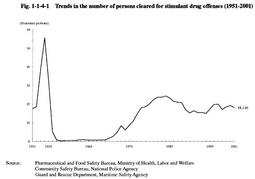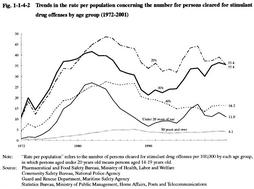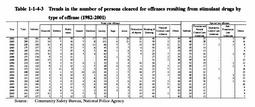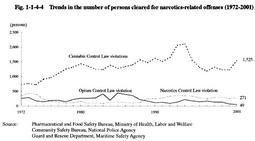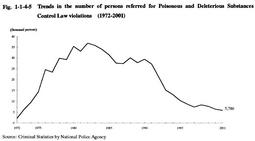| Previous Next Index Image Index Year Selection | |
|
|
1 Trends in drug offenses (1) Stimulant drug offenses In Japan, drug abuse began to become widespread during the chaotic postwar period, and has experienced 2 boom periods till now. The initial phase of widespread drug usage is called the first boom period, and in 1951 during this period, the Stimulant Drug Control Law was established. Fig. 1-1-4-1 shows the number of persons cleared for stimulant drug offenses from 1951 to 2001, which fell sharply after peaking at 55,664 in 1954. As for reasons behind this trend, it had been pointed out that penal regulations were strengthened in 1954 and 1955, that clearance by police was implemented thoroughly, and that educational campaigns were nationally held concerning the harmful influence of stimulant drugs. However, the number of persons cleared for stimulant drug offenses took rose again in 1970 and reached 24,372 in 1984, entering the second boom period. Since then, it has hovered within the range of 20,000 or over but below 30,000 until 1988, but fell below 20,000 in 1989 and decreased to 14,896 in 1994. However, it has been on a generally increasing trend since 1995. In 2001, however, the number of persons cleared for stimulant drug offenses decreased to 18,110 (down 5.5% from the previous year).
Fig. 1-1-4-1 Trends in the number of persons cleared for stimulant drug offenses (1951-2001) Fig. 1-1-4-2 Trends in the rate per population concerning the number for persons cleared for stimulant drug offenses by age group (1972-2001) Fig. 1-1-4-2 shows the trends in the number of persons cleared per 100,000 for stimulant drug offenses by age group during the 30 years since 1972. The number of persons cleared was greatest among those aged 30-39 until 1981, and subsequently, among those aged 20-29. Additionally, the number of persons cleared rose among juveniles aged 19 or younger and among those aged 20-29 between 1995 and 1997, and since then has remained at a comparatively high level. The high repeat offense rate by stimulant drug offenders may suggest a possible increase in the youth cleared in the future.Table 1-1-4-3 shows the trends in the number of persons cleared for offenses resulting from stimulant drugs by type of offense, what are termed, the secondary offenses, for the 20 years since 1982. The number of persons cleared fell sharply from 416 in 1982 and broke 200 in 1985. Then, it hovered within the range of 100 or over but below 200 every year except in 1989, 1993, and 1997, and reached 147 in 2001. Viewed from percent distribution trends by type of offense, larceny and bodily injury have been remarkably decreasing. Table 1-1-4-3 Trends in the number of persons cleared for offenses resulting from stimulant drugs by type of offense (1982-2001) (2) Narcotics-related offenses Fig. 1-1-4-4 shows the trends in the number of persons cleared for narcotics-related offenses (violations of the Narcotics Control Law, Opium Control Law, and Cannabis Control Law; hereinafter the same in this section) during the 30 years since 1972.
The number of persons cleared for Cannabis Control Law violations had been rising overall, despite experiencing repeated increases and decreases, and reached 2,103 in 1994. However, it then fell sharply and has more or less hovered around 1200 to 1,300 since 1996. However, the number of persons ordinarily received by the public prosecutors offices was 1,500 in 1999, increasing to 1,613 in 2000, and 2,096 in 2001, which was a remarkable increase in recent years. By age group, for cannabis and narcotics-related offenses, the numbers of persons cleared and persons ordinarily received by public prosecutors offices are high among persons in their 20s, and for opium offenses are high among persons aged 50 or over. Fig. 1-1-4-4 Trends in the number of persons cleared for narcotics-related offenses (1972-2001) (3) Poisonous and Deleterious Substances Control Law violations Fig. 1-1-4-5 shows the trends in the number of persons referred for Poisonous and Deleterious Substances Control Law violations since 1972. The number of persons referred for Poisonous and Deleterious Substances Control Law violations is the second highest, following Stimulant Drug Control Law violations. The number, which in particular had increased since 1973, hovered within the range of 30,000 or over but below 40,000 from 1980 until 1984. However, it has fallen sharply since 1991 and decreased to 5,786 in 2001, almost 1/7 of the figure at its peak.
Fig. 1-1-4-5 Trends in the number of persons referred for Poisonous and Deleterious Substances Control Law violation (1972-2001) |
